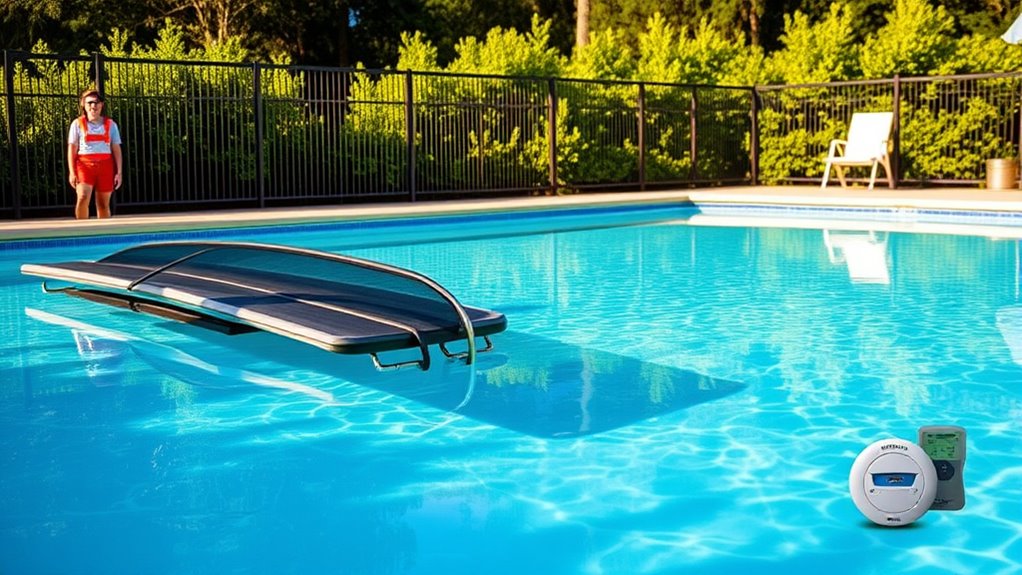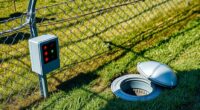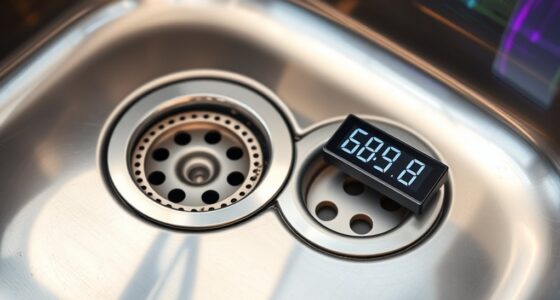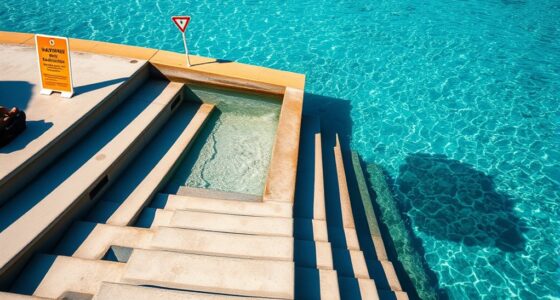To protect against silent drowning, you need five safety layers around your pool. Start with sturdy fencing and gates that self-latch, ensuring kids can’t access the water alone. Install alarms on doors and pool areas, plus surveillance or water sensors for real-time alerts. Use pool covers and enclosures to prevent accidental falls, and keep rescue equipment nearby. Most importantly, supervise kids constantly and enforce clear rules. Want to learn how to combine these layers effectively? Keep going to find out more.
Key Takeaways
- Install sturdy, self-latching fences and gates to create a physical barrier preventing unsupervised access.
- Use pool alarms and sensors to provide immediate alerts if someone enters the water unexpectedly.
- Cover pools with safety covers or enclosures to prevent accidental falls when the pool is not in use.
- Keep essential safety equipment nearby, such as reach poles and rescue rings, for quick emergency response.
- Enforce consistent supervision and clear pool rules to actively monitor and reduce drowning risks.
Fencing and Barriers

Have you considered how effective fencing and barriers can be in preventing drownings? Installing a sturdy, self-closing fence around your pool creates a physical barrier that keeps children and pets out when you’re not supervising. The fence should be at least four feet high with a latch that’s out of reach for young kids. Gates should swing inward and be self-latching, ensuring they stay closed. Barriers prevent accidental access and reduce the risk of unsupervised entry. Regularly inspect and maintain fencing to ensure it remains secure and effective. Remember, fences are a vital layer of protection, acting as a first line of defense against accidental drownings. Properly installed barriers give you peace of mind and help keep your loved ones safe. Incorporating vertical storage solutions for pool equipment and safety gear can further enhance organization and quick access during emergencies.
Alarms and Monitoring Systems
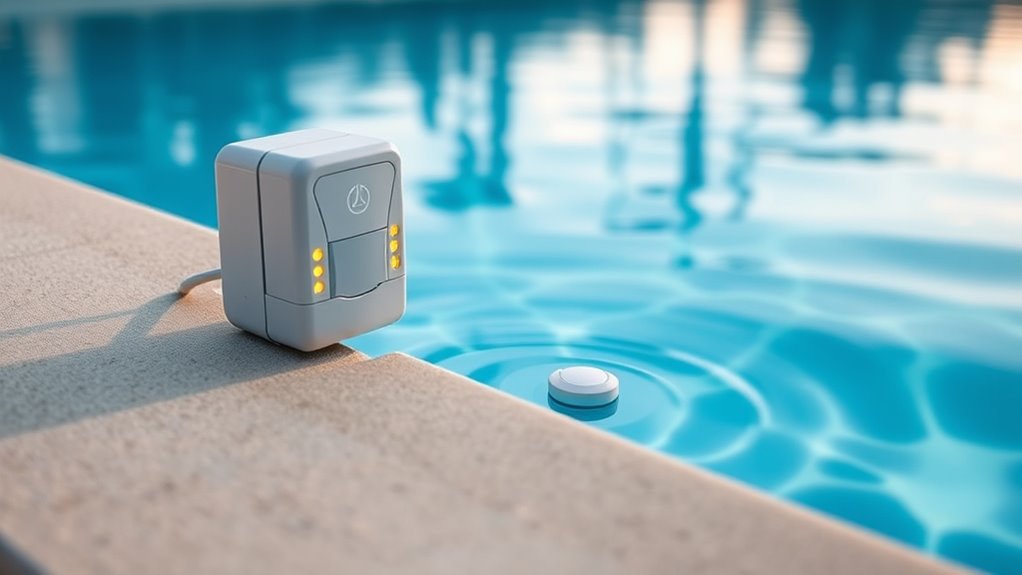
While fences and barriers considerably reduce accidental access, they aren’t foolproof. That’s where alarms and monitoring systems come in. A pool alarm alerts you immediately if someone enters the water unexpectedly, giving you quick response time. Door alarms on nearby exits can signal when someone leaves the house or enters the pool area. Wireless water sensors detect movement or submersion, triggering alerts on your phone or alarm system. Monitoring systems can also include surveillance cameras, allowing you to keep an eye on the pool area remotely. These tools add an extra layer of safety, especially when supervision isn’t constant. Additionally, electric bikes are equipped with advanced safety features, such as speed limiters and anti-theft systems, which can serve as inspiration for enhancing pool safety measures. Remember, alarms are most effective when tested regularly and maintained properly. They serve as an essential safeguard, providing peace of mind and prompt notifications to prevent tragedy.
Pool Covers and Enclosures
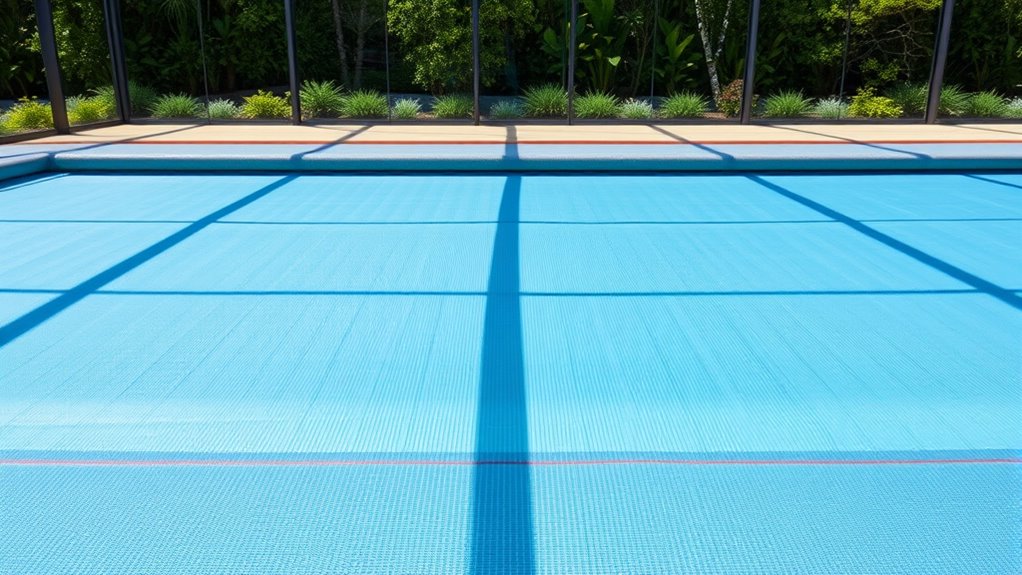
Pool covers and enclosures are among the most effective ways to prevent accidental drownings, especially when supervision isn’t always possible. A sturdy, properly fitted cover can prevent children and pets from falling into the water when the pool isn’t in use. Automatic covers are convenient and secure, making it easy to cover the pool quickly. Enclosures, such as fencing with self-latching gates or screened enclosures, create a physical barrier that keeps kids out. These barriers reduce the risk of unsupervised access. Regularly inspecting and maintaining covers and enclosures guarantees they remain secure and effective. While they shouldn’t replace supervision, they add an essential layer of protection, giving you peace of mind knowing that your pool is less accessible to children and pets when not in use. The effectiveness of these safety features can be enhanced when combined with security zone info, ensuring comprehensive protection around your pool area.
Safety Devices and Equipment
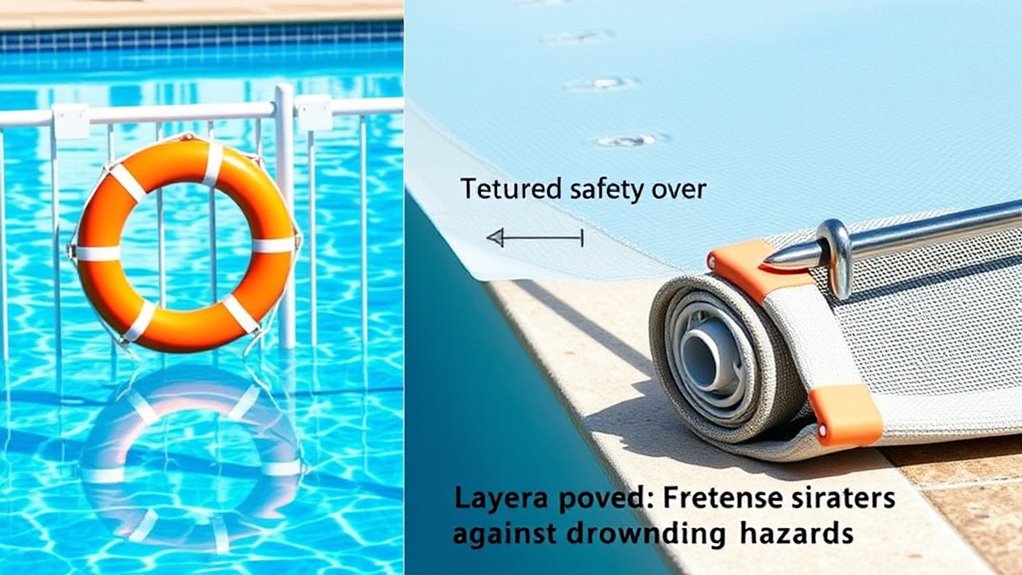
Equipping your pool area with appropriate safety devices and equipment considerably reduces the risk of drowning. Life-saving equipment like reaching poles, shepherd’s hooks, and rescue rings should be easily accessible nearby. Install alarms on doors and windows that lead to the pool area to alert you if someone enters unexpectedly. A reliable pool alarm detects movement or water disturbance, providing an extra layer of warning. Keep a well-stocked, age-appropriate first aid kit close at hand for emergencies. Fencing alone isn’t enough; safety devices support quick response if an accident occurs. Regularly check that all safety equipment is in good working condition and within reach. These tools empower you to act swiftly and effectively, helping prevent tragedy before it happens. Additionally, maintaining a safe and organized environment can help minimize hazards around the pool area.
Pool Rules and Supervision

Having safety devices and equipment in place is a vital step, but they only work effectively when combined with clear rules and vigilant supervision. You need to set simple, consistent rules, like no running or diving in shallow areas, and guarantee everyone understands them. Always watch your children closely when they’re in or near the pool—distractions can be deadly. Designate a dedicated supervisor who stays alert without distractions like phones or conversations. Keep children within arm’s reach at all times, especially if they’re inexperienced swimmers. Enforce pool rules firmly and consistently, making sure everyone knows safety comes first. Supervision isn’t just a quick glance—it’s active, engaged, and continuous. Incorporating active supervision practices further reduces the risk of accidents and drowning. This layered approach greatly reduces the risk of accidents and drowning.
Frequently Asked Questions
How Effective Are Pool Alarms Compared to Physical Barriers?
Pool alarms are helpful but not as effective as physical barriers. Alarms alert you when someone enters the water unexpectedly, but they rely on detection and can sometimes be false or missed. Physical barriers, like fences or covers, prevent unauthorized or accidental access altogether. For the best safety, you should combine alarms with sturdy barriers, creating multiple layers of protection that considerably reduce drowning risks.
Can Pool Covers Prevent All Types of Drownings?
Pool covers can’t prevent all types of drownings. While they help keep debris out and reduce accidental access, they aren’t foolproof. Kids or pets can still slip underneath or get trapped if the cover isn’t properly secured or fails. You need multiple safety layers, like alarms, fencing, and supervision, to truly protect everyone. Relying solely on a pool cover leaves gaps that can be dangerous.
What Safety Devices Are Most Reliable for Young Children?
You should prioritize a combination of safety devices for your young children, as no single solution is foolproof. Install certified pool alarms that alert you instantly if they enter the water. Use a snug-fitting, Coast Guard-approved life jacket during pool play. Keep a reachable, sturdy rescue hook nearby, and always maintain vigilant supervision. These layered protections work together to prevent tragedy and give you peace of mind.
How Often Should Pool Safety Equipment Be Inspected?
You should inspect your pool safety equipment at least once a month to make certain it’s in good working order. Check that safety covers are secure, alarms are functioning, and life-saving devices are easily accessible. After storms or heavy use, perform additional checks. Regular inspections help prevent accidents by catching issues early. Keep a maintenance log and replace any damaged or expired equipment promptly to maintain a safe swimming environment for everyone.
Are There Legal Requirements for Pool Safety Measures?
Yes, there are legal requirements for pool safety measures that you must follow! These rules are like the backbone of pool safety, demanding you install fences, alarms, and safety covers to prevent accidents. Local laws often specify pool barriers, gate latches, and safety equipment inspections. Ignoring these rules can lead to hefty fines or worse, tragic accidents. So, stay ahead of the game and keep your pool area compliant and safe!
Conclusion
Remember, a pool is a beautiful escape, but it can turn dangerous in an instant. Envision the quiet, shimmering surface hiding unseen risks, like a whisper of danger beneath the calm. By installing sturdy barriers, sounding alarms, using covers, equipping safety devices, and enforcing rules, you create a layered shield of protection. Stay vigilant, and keep that sparkling water a place of joy and safety—because drowning happens silently, and prevention starts with you.
